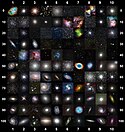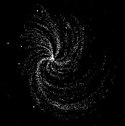Messier 99
| Galaxie Messier 99 | |
|---|---|
 | |
| aufgenommen mithilfe des Very Large Telescope | |
| AladinLite | |
| Sternbild | Haar der Berenike |
| Position Äquinoktium: J2000.0, Epoche: J2000.0 | |
| Rektaszension | 12h 18m 49,6s[1] |
| Deklination | +14° 24′ 59″[1] |
| Erscheinungsbild | |
| Morphologischer Typ | SA(s)c;LINER HII[1] |
| Helligkeit (visuell) | 9,7 mag[2] |
| Helligkeit (B-Band) | 10,4 mag[2] |
| Winkelausdehnung | 5,3′ × 4,6′[2] |
| Positionswinkel | 51°[2] |
| Flächenhelligkeit | 13,0 mag/arcmin²[2] |
| Physikalische Daten | |
| Zugehörigkeit | Virgo-Galaxienhaufen, LGG 285 |
| Rotverschiebung | 0.008029 ± 0.000010[1] |
| Radialgeschwindigkeit | +2407 ± 3 km/s[1] |
| Hubbledistanz vrad / H0 | (105 ± 8) · 106 Lj (32,3 ± 2,3) Mpc [1] |
| Geschichte | |
| Entdeckung | Pierre Méchain |
| Entdeckungsdatum | 15. März 1781[3] |
| Katalogbezeichnungen | |
| M 99 • NGC 4254 • UGC 7345 • PGC 39578 • CGCG 099-011 / 098-144 • MCG +03-31-99 • IRAS 12162+1441 • 2MASX J12184962+1424593 • VCC 307 • GC 2838 • h 1173 • HIPASS J1218+14 | |
Messier 99 (auch als NGC 4254 bezeichnet) ist eine +9,7 mag helle Spiralgalaxie mit einer Flächenausdehnung von 5,3' × 4,6' im Sternbild Haar der Berenike.
M99 wurde am 15. März 1781 zusammen mit den benachbarten Spiralgalaxien M98 und M100 von Pierre Méchain entdeckt. Sie war nach der Whirlpool-Galaxie M51 die zweite Galaxie, deren Spiralstruktur entdeckt wurde, und zwar von Lord Rosse im Jahr 1846. Er kommentierte seine Entdeckung mit den Zeilen:[4]
„Spirale mit einem hellen Stern darüber; ein dünner Teil des Nebels reicht über diesen Stern hinaus. Die Hauptspirale liegt unten und ist rechtsdrehend.“
M99 ist eine Galaxie vom Hubble-Typ Sc, die wir beinahe frontal sehen. Eigentümlich an der Gestalt der Galaxie ist jedoch ihr verrutschter Kern, der im Bild deutlich nördlich des Zentrums der Spirale liegt. Die Galaxie liegt am nördlichen Rand des Virgo-Galaxienhaufens in der Nähe der Spiralgalaxie M98. Es gibt Mutmaßungen, dass der verrutschte Kern und die Nähe dieser beiden Galaxien kein Zufall sind, sondern auf einen Vorbeiflug aneinander in der Vergangenheit hindeuten.[5] Diese Spekulation wird zusätzlich durch die Tatsache genährt, dass beide Galaxien entgegengesetzte und zugleich hohe Pekuliargeschwindigkeiten besitzen.
Zeichnung von William Parsons, 1848
Frühe fotografische Aufnahme, Isaac Roberts, 1896
Hochaufgelöste Aufnahme des Hubble-Weltraumteleskops, 2020
Panoramaaufnahme mit dem 81-cm-Spiegelteleskop des Mount-Lemmon-Observatoriums
VirgoHI21
Untersuchungen eines Teams um Pierre-Alain Duc[6] im Jahr 2007 haben ergeben, dass die Galaxie M98 (NGC 4192) nicht nur für die Deformation von M99 verantwortlich zeichnet, sondern auch für die als Prototypen der Dunklen Galaxien geführte Struktur VirgoHI21.[7] Den Untersuchungen zufolge zog M98 vor 750 Millionen Jahren mit einer Relativgeschwindigkeit von 1125 km/s nahe an M99 vorbei und entriss ihr dabei sehr viel Wasserstoff, der nun die Struktur bildet.
Weblinks
- Tidal Debris posing as Dark Galaxies. arxiv:0707.3991
- M99 bei SEDS
- Erste dunkle Galaxie gefunden?
- Amateuraufnahmen. Spektrum.de
- A bright spark in a nearby spiral galaxy(engl.)
- Hubble Sees Double in M99 (engl.)
- A multi-beam HI survey of the Virgo Cluster – two isolated Hi clouds? arxiv:astro-ph/0312531
Einzelnachweise
- ↑ a b c d NASA/IPAC Extragalactic Database
- ↑ a b c d e NGC 4254 SEDS
- ↑ Seligman
- ↑ (Übersetzung aus dem Englischen nach messier.seds.org)
- ↑ messier.seds.org
- ↑ arxiv:0707.3991
- ↑ Claudia Michalecz: Erste dunkle Galaxie gefunden? Raumfahrer Net e.V, 5. Februar 2005, abgerufen am 9. September 2019.
Auf dieser Seite verwendete Medien
Autor/Urheber:
diverse
, Lizenz: CC-by 3.0Bildtafel der 110 Messier-Objekte.
Autor/Urheber: Credit Line and Copyright Adam Block/Mount Lemmon SkyCenter/University of Arizona, Lizenz: CC BY-SA 3.0 us
Picture Details:
Optics 32-inch Schulman Telescope (RC Optical Systems), Acquired remotely Camera SBIG STX 16803 CCD Camera Filters AstroDon Gen II Dates January 2012 Location Mount Lemmon SkyCenter Exposure LRGB = 250:70:70:70 minutes Acquisition ACP Observatory Control Software (DC-3 Dreams),TheSky (Software Bisque), Maxim DL/CCD (Cyanogen) Processing CCDStack (CCDWare), Photoshop CS5 (Adobe), PixInsightCredit Line and Copyright Adam Block/Mount Lemmon SkyCenter/University of Arizona
Autor/Urheber: Judy Schmidt, Lizenz: CC BY 2.0
Grand design spiral galaxy NGC 4254 or Messier 99 seen as only Hubble can see, with a full set of nearly visible light red, blue, and green filters, with extra near-ultraviolet data to make those young blue star clusters pop.
Data from the illustrious PHANGS-HST program were used to create this image. archive.stsci.edu/proposal_search.php?mission=hst&id=...
More on PHANGS here: phangs.stsci.edu/
A single F814W exposure also uses data from the following proposal: PTF10fqs: A Luminous Red Nova in the Spiral Messier 99
Red: WFC3/UVIS F814W Green: WFC3/UVIS F555W Blue: WFC3/UVIS F438W+F336W+F275W
North is 26.9° counter-clockwise from up.Autor/Urheber: (Credit) ESO, Lizenz: CC BY 4.0
Grand designs
This ESO Picture of the Week features a galaxy named both NGC 4254 and Messier 99, a beautiful cosmic spectacle located in the constellation of Coma Berenices (Berenice’s Hair).
Messier 99 is special, owing to its classification as a grand design spiral galaxy: a kind of galactic architecture featuring strong, prominent, well-defined arms that wrap clearly around the galaxy’s centre. Only around 10 percent of all spirals are of the grand design variety, making objects like Messier 99 somewhat uncommon. The justification behind Messier 99’s categorisation is clear in this image; bright, swirling arms carve through the dark surrounding space, and are easily identifiable as a number of different, coherent structures.
This image was created as part of the ESO Cosmic Gems programme, an outreach initiative to produce images of interesting, intriguing or visually attractive objects using ESO telescopes, for the purposes of education and public outreach. The programme makes use of telescope time that cannot be used for science observations. All data collected may also be suitable for scientific purposes, and are made available to astronomers through ESO’s science archive.
Credit:
ESO
Coordinates Position (RA): 12 18 48.50 Position (Dec): 14° 25' 4.91" Field of view: 6.98 x 6.97 arcminutes Orientation: North is 0.0° right of vertical
Colours & filters Band Telescope Optical B 440 nm Very Large Telescope FORS2 Optical V 557 nm Very Large Telescope FORS2 Optical R 655 nm Very Large Telescope FORS2 Optical H-alpha 660 nm Very Large Telescope FORS2.











